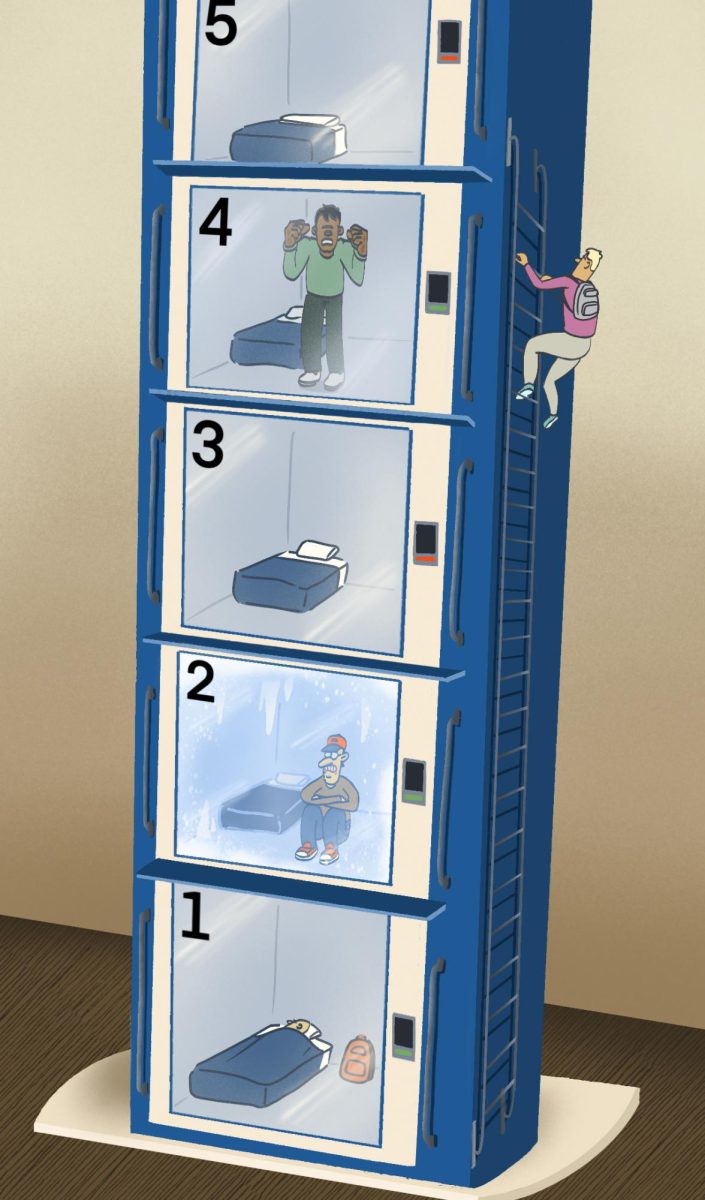Do you ever drift off to sleep in the middle of class only to wake up to your professor sitting alone in an empty classroom, staring at you with an unblinking, disappointed gaze? Do you ever wake up in the odd hours of the morning, face-down in a plate of cold ramen noodles? Do you ever get on a train, lose consciousness and snap back to reality in a completely unfamiliar place with a completely unfamiliar family who, despite your better judgment, claims they’ve known you your whole life? If any of these scenarios sound familiar, you most likely suffer from the deadly disease of sleep deprivation, a disease that, if left untreated, could lead to getting tired and falling asleep.
Lack of sleep is the single most dangerous epidemic that college students suffer from, but there’s no need to lose hope just yet. University Health Services has recently partnered with the company, Afterlife Snoozers, to provide the student body with an answer to the sleep crisis: Sleeper Pods. A Sleeper Pod functions in much the same way that the phone charging towers in the Campus Center work. You set a secure code, the door pops open and you lock your device inside to have its energy restored. Of course, in the case of Sleeper Pods, the device happens to be you, but the concept is the same.
There are current plans for pod towers to be installed in every campus building with the obvious exception of Wheatley due to the fact that falling asleep there almost always means that you’re not waking up. Each tower will be comprised of five pods, stacked on top of each other with a ladder on the side for ease of access. The hope of the administration is that by implementing these Sleeper Pods, students will have safe, private places to catch some z’s in between classes. However, despite the University’s enthusiasm, some people have doubts in regard to the safety of the pods. It may come as a shock, but one of those people is Dampe Dinklemiester, the CEO of Afterlife Snoozers.
“Look, I’m just trying to avoid a lawsuit here!” Dinklemiester said quickly and manically, as if trying to pre-emptively cover his a—. “I told these university guys again and again, I’ve never tested these pods with kids, not to mention live ones! It’s anyone’s best guess what’s gonna happen, but hey, Dampe Dinklemiester don’t say no to a quick buck.”
Dampe’s concerns for his own product stem from the fact that the pods weren’t originally intended for the use of living people; they were designed for the morgue market as a space-saving, cost-effective way of storing higher quantities of corpses. That being said, the pods offer amenities engineered to serve that original purpose. Such features include a built-in odor dampener to lessen the scent of decomposing flesh and an adjustable temperature control that could be configured for either extreme cold, to preserve the bodies, or for extreme heat, to cremate the bodies.
Some have raised concerns over the fact that no modifications have been made to the pods following their transition to the college market. One of the largest concerns is the fact that there is no middle ground between bone-chilling cold and scorching heat. However, according to Dampe, “The heaters take a little bit to get going so you probably got a while before your skin melts off.” After conducting tests on dummies, the time until the pods reach inferno level appears to be about twenty minutes.
Another issue raised about the pods is the fact that they can’t be opened from the inside. According to Dampe, this “security feature” was designed in the event of a potential zombie apocalypse. The only way to be released is to have a friend enter the code on the number pad. Of course, if they forget about you, it’s likely you’ll be turned into either a popsicle or a pile of ashes depending on what you, or your trusted friend, happens to be in the mood for. Really, these pods seem to encourage foul play. And speaking of foul play, Dampe has plenty to say on the matter:
“So pretty much, we started running into this problem straight from the get-go. The pods are only built to fit one body, but technically, you could probably stuff two in there if you really tried. I mean, that isn’t gonna give you much space to work with, but hey, there’s a lot of lazy lovers out there.”
In order to avoid backlash and shut up the naysayers, the University decided it was in their best interest to conduct tests using actual, living students before implementing the pods across campus. The test subjects up until this point have consisted primarily of freshmen, and out of one hundred trials, it is currently being reported that only forty-two of them perished by means of ice or fire. Another thirty-eight reported an array of mild side effects ranging from hypothermia to third-degree burns. That means that a whopping twenty percent made it out completely unscathed.
Although the administration feels the results of the trials were “good enough,” more testing is planned to take place before the pods are rolled out. University Health Services is projecting that the pods should be available for use by the end of the semester, but is this really a good thing? In my opinion, it is. Sure, the pods appear to present some minor risks—which have been made abundantly clear by the man who created them as well as the University’s test results—however, these risks pale in comparison to the risks of not getting good sleep. And if you do happen to get accidentally burnt to a crisp or frozen solid, at least you’ll be able to rest in peace knowing that you tried.
Sleep soundly, my friends.

